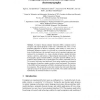12 search results - page 2 / 3 » Measuring affect in hci: going beyond the individual |
TSE
2002
13 years 5 months ago
2002
Measurement programs in software organizations are an important source of control over quality and cost in software development. The findings of this research presented here are ba...
HCI
2007
13 years 7 months ago
2007
To reduce the workload of the driver due to the increasing amount of information and functions, intelligent agents represent a promising possibility to filter the immense data sets...
ACSAC
2003
IEEE
13 years 11 months ago
2003
IEEE
In-depth analysis of network security vulnerability must consider attacker exploits not just in isolation, but also in combination. The general approach to this problem is to comp...
ECCV
2006
Springer
13 years 9 months ago
2006
Springer
To improve human-computer interaction (HCI), computers need to recognize and respond properly to their user's emotional state. This is a fundamental application of affective c...
CHI
2006
ACM
14 years 6 months ago
2006
ACM
Fitts' law, relating the time to acquire a target to the target size and the distance from the target, is an effective and widely used predictor of performance in feedback co...

